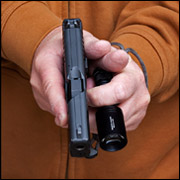Do you still stand by the post below or has your thinking changed some what?I agree with Archer1440's post above, but would add that if you're competent enough to safely handle and carry a handgun, you should most certainly be competent enough to handle and carry unprotected cells (or any Li-ion cells for that matter) by following a few basic safety rules. The first bullet point here covers them, the rest of the points delve into the minutia.
That said, IMO WMLs should be powered by primary cells (CR123 batteries). They hold a charge much longer (for weapon storage considerations), can handle cold temperatures better and are (for the most part) safer to handle.
Protected vs. unprotected - I use both, depending on the light and who's using it. For the lights I carry, I use unprotected cells.
The biggest benefit of a protected cell in terms of human safety is if the battery is shorted, the protection circuit will open (like a circuit breaker) and prevent the user from catastrophic cell failure (fire, possible explosion). Of course the only way to short the cell is to do something stupid, like placing the cell in a pocket with keys and/or loose change. As long as the cell remains in the flashlight or is stored in the container it came with when not in use, you'd have to work pretty hard to have accidental shorting. IMO, if you're competent enough to be handling/carrying a pistol, you're competent enough to use unprotected cells.
Another point to consider - unprotected IMR flat top cells use a different chemistry than protected cells. IMR cells have lower capacity, but also lower internal resistance so they can handle higher current before overheating - which provides an important safety edge.
The circuit also protects the cell from over-discharge, which would shorten its life. In a single-cell light, you're likely to notice considerable dimming before the cells drops below 2.5V under load and the protection circuit opens. If the light has become noticeably dim during use, change or recharge the cell. In multi-cell lights, it's far more likely the cells will become over-discharged before the light noticeably dims. In this case, you either have to be more vigilant on tracking run time or use protected cells. For our "walk-the-dogs" multi-cell light that my wife also uses, it runs on protected cells for this reason.
The protection circuit is a thin wafer PCB on the negative end of the cell. One consequential knock against protected cells is that the wafer can be damaged or fail, causing the light to become inoperative even if the cell has plenty of charge. For this reason, many "in the know" consider the use of protected cells in critical-use lights (especially WMLs that are subject to recoil) as a non-starter.
Does this mean use CR123's?
In summary, unprotected cells offer improved durability, reliability and higher current handling for critical-use devices with little-to-no downside for the knowledgeable user. For lights that are not critical-use and/or going to be used by those who have not been educated on the safe use and handling of Li-ion cells, the use of protected cells is prudent.




 Reply With Quote
Reply With Quote
